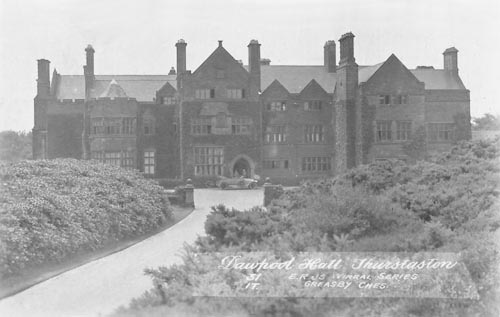Dawpool
Cheshire
| Location | Thurstaton | ||
| Year demolished | 1927 | ||
| Reason | Surplus | ||
| See all images: | Gallery | ||
| << Back to the main list |
Some houses last for hundreds of years before finally vanishing whilst others can be built and vanish in a few decades. Dawpool was one man's pleasure and his passing also signalled the beginning of the end of the house - its demolition coming a mere 43 years after it was built.
 Dawpool was the home of Thomas Henry Ismay, a shipowner, who, having bought the White Star Line for £1,000 when he was 30, created a company large enough to conceive and build the Titanic. Ismay bought the 390-acre estate in 1877 and demolished the existing house - itself only built in 1865 - and brought in Richard Norman Shaw to create a replacement. The house was designed to be a pleasure building - not a working building at the heart of an estate. The wealthy Victorians earned their money in the vast industrial works or in the shipyards and therefore did not need extensive landholdings to provide an income. However the houses they built had to fulfil the traditional role of the country house in demonstrating the power, prestige and wealth of the owner.
Dawpool was the home of Thomas Henry Ismay, a shipowner, who, having bought the White Star Line for £1,000 when he was 30, created a company large enough to conceive and build the Titanic. Ismay bought the 390-acre estate in 1877 and demolished the existing house - itself only built in 1865 - and brought in Richard Norman Shaw to create a replacement. The house was designed to be a pleasure building - not a working building at the heart of an estate. The wealthy Victorians earned their money in the vast industrial works or in the shipyards and therefore did not need extensive landholdings to provide an income. However the houses they built had to fulfil the traditional role of the country house in demonstrating the power, prestige and wealth of the owner.
Shaw recognised this and produced a building described by Country Life magazine as 'a fine and acknowledged masterpiece'. The foundation stone was laid in 1882 and took four years to build. It was meant to last - construction was of the highest quality using local red sandstone and only the best brass screws with the total cost reputedly exceeding £50,000 (approx. £3.6m - 2007). The lodges and stable block were also built in the same style and quality and today stand as a testament to high standards of the builder and client.
Despite the obvious quality of the house, less thought had been put into its setting. Looking out over the Dee Estuary towards Wales the views were splendid but the lack of extensive grounds, or flower gardens or parkland probably made the house seem somewhat over-bearing nestled in its hollow, part way up a gently rising hill. There was also few trees and the exposed estuary position meant that it was the hardier but duller plants which thrived.
Thomas Henry Ismay wasn't to enjoy Dawpool for long, dying in 1899. His widow and son stayed in the house until 1907 but neither felt any great affection for it - as long ago as 1897 Mrs Ismay had told Shaw that the house had served its purpose in keeping Thomas Ismay amused for fifteen years. The house was sold to a Mr F.W.P. Rutter who loaned it for use as an officer's orthapaedic hospital during the First World War. The last function to be held there was a garden party in September 1926 in aid of the local cottage hospital. By this time Dawpool had been sold to Sir Henry Roberts - though he never moved in.
Following a sale of interior and exterior fixtures and fittings the house was demolished in 1927. Explosives had to be used such was its solid construction. One of the huge and ornate fireplaces can still be seen in The Pantheon in Portmeirion. A new, smaller house was eventually built on the footprint of Dawpool and apparently incorporates some of the extensive cellars.